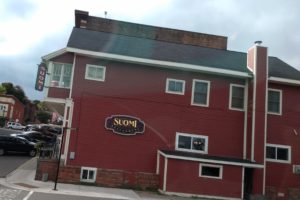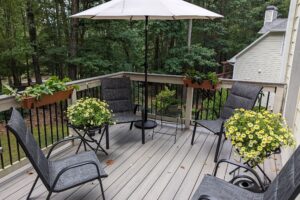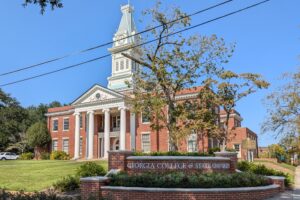Have you ever thought that you could never make a difference in your life, your family, or where you live? Me too. But today’s story gives us a view of how one man and his family made a huge impact where they lived for 4 generations. And from their story we get to learn about cattle ranching and how people lived in Carson Valley.

This is the story of the Dangberg family starting with Heinrich Dangberg in the mid-1850s. The site we went to is Dangberg Home Ranch Historic Park in Minden, Nevada. This ranching family started out in a cabin and grew to living in this house and having many out buildings over the years. Since they never threw anything away, the family has left us a wonderful collection of items, pictures, and documents starting from the early 19th century up to 1990. Many of these reflect daily life in Carson Valley, while others show the family’s private lives.
first generation (if you’re not that interested in the history of the family, scroll on down to let’s tour)
In 1848, Heinrich Dangberg left Germany to come to America when he was 18. By 1856 he settled in Carson Valley after building a log cabin and clearing and irrigating a parcel of land. After getting swindled out of this home site, he convinced his brothers to come to Carson Valley (preferably with wives) from Germany and settle here so he’d have family around that he could trust.
Since he had lost land once, he knew he wanted to leave his growing ranch to his own family rather than to people he didn’t know. The Ferris family (remember the Ferris wheel from a previous post?) had moved into the area, and he met Margaret, who was 18 years younger. They married and had 6 children. The cabin he had built grew into the house we have today as he and his sons added to what he started.
Dangberg was known for his hard work, foresight, and leadership in the community. His influence grew as he grew his ranch. In 1902, Son 1 (born 1866) encouraged the family to form the Dangberg Land and Livestock Company, and the three sons took over the leadership with the parents still involved for a while. The family’s holdings got up to 48,000 acres supporting cattle and sheep, vegetables, and other products; the ranch was the largest in Carson Valley. He was so highly respected by his peers that he was elected to serve in the Nevada state legislature for 3 terms.
second generation
Heinrich Sr. died in 1904, knowing his sons were already taking over the ranch that he started and expanded. Son 1 had his dad’s ability to interact with others and network; this ability helped the business survive during the depression as he was able to make the contacts needed to run the ranch. Son 2 (born 1871) was the businessman and survived his brothers. Son 3 (born 1875) was the buffer between Sons 1 and 2. Son 4 didn’t want anything to do with the business and made his own way in the area.
The daughter wasn’t part of the business (women at that time and all that), and the 6th child, Albert, died at age 2 (1868-1870). The daughter, Eva Catherine, was born in 1873 and died in 1973 in Santa Barbara at age 100! She had been married, but her husband, George Greenfield, died in 1927. You noticed that I gave her name and her husband’s name? Since she wasn’t included in the business, I decided I needed to give more information about her. If I remember correctly, our docent said she spent much of her time with her mother in Alameda before her mother died in 1946 at the age of 97. On the websites about Eva, the writers used her maiden name rather than her married name, perhaps because she lived so long after her husband died
Son 1 decided he and his family got the ranch after dad died in 1904 (and mom had moved away). He raised his daughters to be young women of wealth and prestige. Genoa was the closest town and was the oldest in the Valley, but wasn’t large enough and didn’t meet his standards. Gardnerville, the next closest town, was started in 1896, but it’s makeup was commerce, not the elite town he wished for his daughters as they grew up. So what’s a father to do? You’re right; he created a town that would suit him and his family and named it after the town in Germany where his father had come from.
In 1905, the family founded the town of Minden, only a few miles away from the ranch, and there, in partnership with other ranchers, established several businesses focused on agriculture, banking, and a beautiful and well known hotel that welcomed the well-to-do in Nevada, the United States, and Hollywood, including Clark Gable and Jean Harlow. The town was laid out on paper before construction ever began.
One of the goals of Son 1 was to bring the railroad to Minden instead of to Gardnerville. He worked his relationships behind the scenes and convinced the owners of the V&T Railroad to not only come to Minden but also to end the rail-line at this town so it would be a destination point and not a throughway. (Some people thought the railroad would continued going south even to Bodie.) Obviously, Gardnerville citizens weren’t happy about this turn of events because they assumed the railroad would come their way since Hwy. 395 went straight through town and their town was already established.
Like his father, Son 1 was a state senator from 1903-1905. For 30 years he served on the livestock commission as well as serving on numerous other boards and associations in the area.
The website about Son 1 states, “It is believed that Henry [Son 1] and his family did more to improve livestock and ranching conditions than any other group or organization in Nevada. The town of Minden will always be a monument to this outstanding family.”
Even today Minden is a nice little town and is the county seat. Population at the last census was just over 3000.

third generation
Son 1 and his wife’s first child was a son who died at age 4 (1899-1904); we’ll see more about him in the pictures further on in this post. Then they had 4 daughters all born from 1901-1911; from what we could tell from our docent, he loved his daughters and pampered them, assuming they would marry well. One of the daughters died in the 1940s and had never married. They other three married but at least 2 got divorces and came back home soon after marrying. One of these daughters had a son who came back with her and became like the son her father never had. (He’s still alive and visits the ranch once a year.) Eventually all three daughters were living in the house at the end of their lives in the mid-1980s and mid-1990s.
After the brother died who was the buffer between Sons 1 and 2 over how to run the business, conflict between the first two escalated. Son 1 tended to take money from the corporation without permission for his gambling debts. Loans from the depression were overwhelming. By the time Son 1 died (1946 at age 79), Son 2 didn’t want to have anything to do with his brother’s daughters. He allowed them to live in the ranch house but wouldn’t provide for their care, so late in life they had to learn how to support themselves. Son 2 passed away in 1958.
fourth generation
The tour guide did say that the son of one of the daughters who lived most of his life in the family home hadn’t known about the conflict between the brothers (grandfather and his brother) and loved growing up in the house. He’s currently in his 80s and is still alive, coming to visit the ranch once a year and sharing stories.
let’s tour
Remember the view of the house at the beginning of this post? That’s the entrance people used when they came to the ranch for the many parties that Son 1 held while living there. Now to the inside.



bedrooms





trunk (on the left) that one of them used for a European trip
family room

one wall was covered with built-in bookshelves filled with books from different generations of the family. Felt like a comfy room.
Do you see the heater on the side wall? I remember my paternal grandfather having one of these oil heaters in the living area of his farmhouse. I always thought it looked so ugly even if it worked well.
dining room




kitchen

the ranch workers.
In early years, cooks were busy cooking for the family and the ranch hands. In later years when the 3 sisters were living here on a tight budget, they usually ate their meals here enjoying the heat that the stove provided.




men’s dining room

the Dangberg family.


pantry



outside
We were able to walk through 2 of the outside buildings next to the house, a brick house for storing food stuffs and the laundry.



dairy room


meat room


laundry room


With 3 daughters, a wife, and numerous parties to clean up after, as well as probably doing laundry for the ranch hands, help was needed with the laundry. A Washo (Indian) woman helped with the laundry and the household chores. We also learned that the grandson played with her son, and she took him on outings with the tribe members.





back of the house


beautiful views and outside equipment



Also on the property owned by the cattle ranch is an 1875 wood barn that was so well made that it’s still in use today. The bunkhouse and cook’s home are still standing. Wish we could have seen these buildings.
Hope you liked this in-depth look at a family that left its mark on the whole Valley. The Dangberg Home Ranch Historic Park helps us learn about this interesting time in Nevada’s history. If you’re ever in the area, please take the time to tour the home supported by The Friends of Dangberg Home Ranch (you’ll need a reservation and they aren’t open every day). My memory of the tour misses so much that is available to see and learn. The 4 generations of this family never threw anything away, so we get a glimpse of every generation. Attics are full of more items that get displayed from time to time. Also, private events can be held at the ranch, and educational and community programs are held there.




